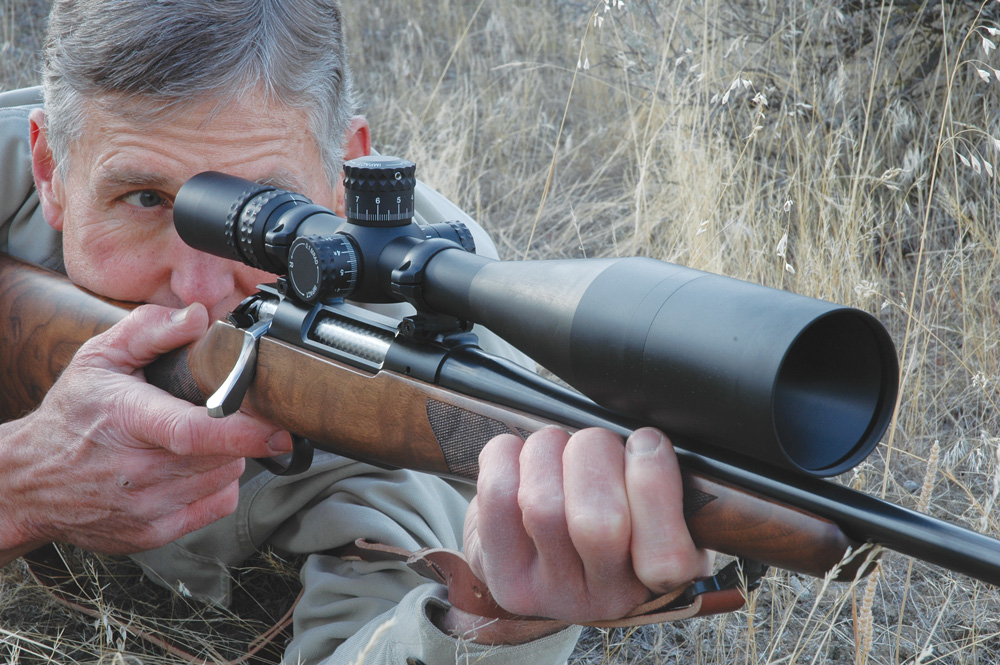At GunDigest, we independently review products. However, we may earn a commission when you purchase through links on our site. Learn More
Best Scope Magnification: How Much is Too Much?

In general, the least magnification that gives you a clear target image is the best scope magnification.
Too much magnification handicaps you in several ways. It shrinks the field of view, so you won’t find the target as quickly as with less. On a hunt, you may not see the huge buck in the shadows to the side of the most obvious animal.
High power reduces exit pupil diameter, so, in dim light, the target image won’t be as bright. The magnification that makes that target bigger also bumps up the amplitude of reticle movements due to muscle tremors and heartbeat.
Reticle quivers you might not even notice at 2½x become violent dips and hops at 10x. At 20x, you’ll see so much chaos in the tighter field, the target may bounce in and out of view as you try to tame that reticle. A scope helps you when it shows movement you can control.
It’s a liability as it amplifies movement you can’t completely control. Instead of applying gradual pressure to the trigger, you wear yourself out fighting the jitterbug image in your sight. As eyes and muscles tire, an accurate shot becomes impossible.
Magnification also shows you mirage, a good thing on days when mirage is light and the target is in reasonable range. But, on hot days, when you’re aiming over great distance, the target may appear as a dim, shapeless object stuck below the surface of a raging river.
In general, the least magnification that gives you a clear target image is the best magnification. I use 4x rifle scopes for most big-game hunting and think it adequate to 300 yards. A 6x works fine for me at 400.
Of course, you’ll want more magnification for small animals like prairie dogs. Deliberate shooting at paper bull’s-eyes and steel gongs brings out powerful glass.
I’ve used 16x, even 20x, scopes to advantage in good light, when there’s time for a solid position and precision trumps all else. In smallbore matches, a 20x Redfield served me well.
I needed that much power to hold on a .22 bullet hole at 50 meters, or shade to the bottom-right quadrant of an X-ring the size of a bottle cap at 100. I’ve used 25x to good effect on bull’s-eyes, but am inclined to think 20x would have served, too. Higher power is very hard to use.
These days, variable scopes offer wide four-, five-, and now six-times power ranges; that is, the highest magnification is four, five, or six times that of the lowest.
So, instead of the 3-9x that once awed sportsmen with its versatility, you can get a 3-12x, a 3-15x, or a 3-18x. Or bump up to 4x on the bottom to get 20x or 24x on the top. Such scopes feature 30mm tubes.
These may or may not have a bigger erector assembly (the tube with lenses and magnification cams held inside the main tube). Those with erector assemblies of standard size for one-inch scopes give you more windage and elevation adjustment. That’s an advantage at long range, though a scope performs best with its optical axis close to its mechanical axis.
This article is an excerpt from Mastering the Art of Long-Range Shooting.
Next Step: Get your FREE Printable Target Pack
Enhance your shooting precision with our 62 MOA Targets, perfect for rifles and handguns. Crafted in collaboration with Storm Tactical for accuracy and versatility.
Subscribe to the Gun Digest email newsletter and get your downloadable target pack sent straight to your inbox. Stay updated with the latest firearms info in the industry.